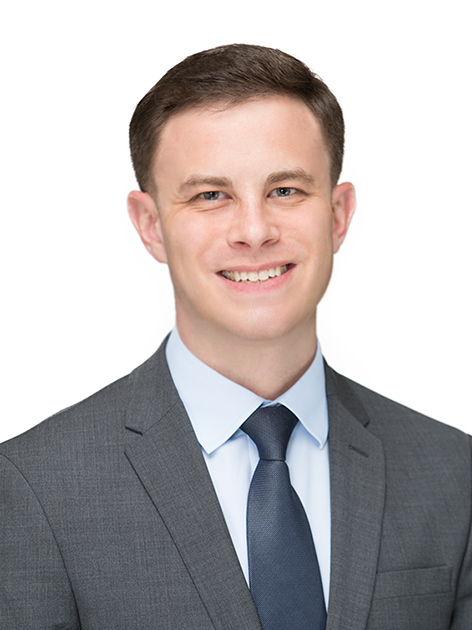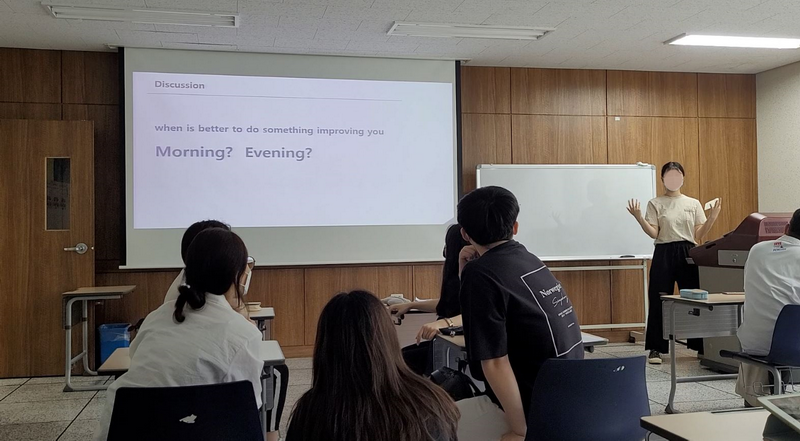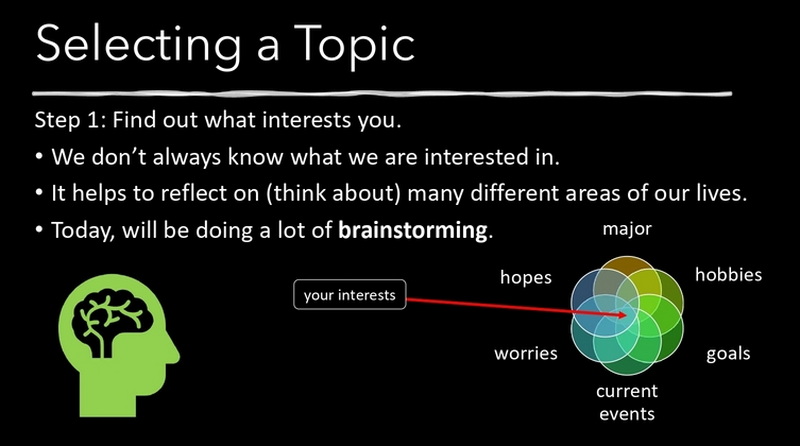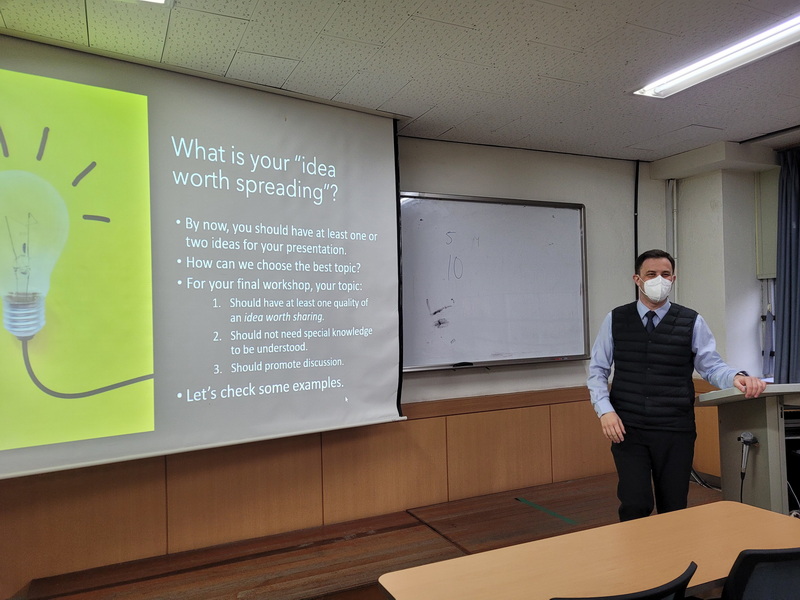Curriculum-Building for Student Workshops
An Interview with Brennand Kennedy
Gwangju is seeing more of Brennand Kennedy around town these days, as he has moved from teaching in Naju to a university position in the city. Brennand completed his MA in applied linguistics (TESL) at Brock University in Canada. As part of his graduate program, he conducted research in the area of reflective practice under the supervision of Dr. Thomas Farrell. In his recent move to Chosun University, Brennand had the opportunity, or need, to do some interesting curriculum-building for his new courses, which he describes in this interview.
Interviewer: Thank you for making time for this interview, Brennand. To begin with, could you tell us a little about yourself before you came to Korea?

Brennand: Absolutely! But first, let me say how honored I am to be able to share my story with the Gwangju community! I was born and raised in Calgary, Alberta, Canada. My mother was an elementary school teacher, and I think she really instilled in me the value of education, even if that did not always translate into good grades. I remember being very fascinated by different languages from an early age, and I was enrolled in the French immersion program when I started school.
Although not all my classmates were as enthusiastic about having to take all their subjects in a foreign language, it kind of became “my thing,” especially in high school when I took part in an exchange program and lived in Grenoble, France. That experience was a seminal one for me as it demonstrated that one may never feel truly “fluent” in a foreign language without plenty of opportunities for meaningful communication in the real world. It is a principle that stuck with me throughout my post-secondary education as I studied linguistics and anthropology, and it was a huge part of why I decided to begin teaching English in Korea.
Interviewer: And next, please tell us about your life in Korea – what brought you here, what you have done, and so forth.
Brennand: I first came to Korea in 2013 when I was hired by the EPIK program. I worked in the tiny village of Hwagae, in Hadong County, Gyeongsangnam-do, where I stayed for almost four years. At first, it was tough living by myself in the middle of the Jiri Mountains, but it really grew on me as I eventually made a lot of local friends and became immersed in the community. As Hadong is one of the major tea-growing regions in Korea, I even studied Korean tea ceremony for the purposes of competing! In addition to cutting my teeth as an English teacher, I also achieved a relatively high proficiency level in Korean due to all the opportunities for real-world communication, the best example of which was when I met my wife at a mutual friend’s wedding! Unfortunately, the Gyeongsang dialect remains a major challenge for me.
Eventually, despite my wonderful students and my newfound love for rural life, I began to feel that my teaching practice had reached a plateau. I felt that my superiors were increasingly pushing me into a babysitter role while simultaneously stifling my attempts to experiment with new (to me) forms of pedagogy. It was KOTESOL, and especially KOTESOL’s magazine, The English Connection, that eventually showed me that there were many more opportunities available to teachers who really want to teach. Inspired by Tom Farrell’s work in reflective practice, I made the decision to go back to Canada for a year to attend graduate school at Brock University.
Upon returning to Korea in 2018, I married my wife and began working at Dongshin University in Naju, where my daughter was born last year. Since starting this new chapter of my life, I have also enjoyed getting more involved with the KOTESOL community by attending and presenting at several KOTESOL conferences and taking part in the local reflective practice group here in Gwangju whenever possible.

Interviewer: I hear that you recently moved into a new teaching position. How has that experience been? For most people, just adjusting to a new job is difficult enough, but having to do that in the midst of the Covid pandemic must have posed some unique challenges.
Brennand: Yes, that is right! After working in Naju for three years, I had the good fortune of being hired by Chosun University in the spring of 2021. Covid did not actually pose as many challenges as one may have expected. After having taught online for the entire previous year, starting work at Chosun felt a lot like a return to pre-Covid times, as the university had just re-implemented in-person instruction for all English courses in our department.
This is not to say that Covid has not presented any challenges, however. Fewer people in the office has meant fewer opportunities to meet and share ideas with all my new colleagues. Adding to this, I arrived at Chosun in the midst of a complete overhaul of the freshmen English language program, which expanded the number of course offerings seven-fold. While it felt exhilarating to join a team of teachers all working together toward a common goal, it could be hard to find guidance when even the veterans were charting new territory.
Interviewer: I know that moving to a new workplace usually entails having to adjust to new courses and curricula, but it must have been especially difficult if all the other staff were also having to go through all the same adjustments. Can you tell us more about some of the specific courses you taught?
Brennand: Sure! Despite some hurdles, I am super excited about the new direction the department has chosen to take. Instead of offering all students the exact same conversational English course, the university began level-testing students prior to class registration and offered a choice of content-based courses for advanced students in addition to the more basic four-skills courses being offered to those who scored lower on the diagnostic tests.
The curricula and materials for all the advanced classes had been designed by other teachers shortly before I started working in my new position. Last semester, an advanced-level class I was tasked with teaching was titled “TED Talks and Current Events.” As anyone who has taught similarly themed courses will surely know, this topic can provide plenty of opportunities for engaging discussion among students. Moreover, since this was still a new program, the course outlines we were given included plenty of gaps for individual teachers to develop as they pleased. This provided the perfect chance for me to take on a small curriculum-building project of my own.

Interviewer: Please tell us about this curriculum-building project that you were involved in – how did you go about it, and how is it working out in practice?
Brennand: When reflecting on how to best fill-out the rest of the course outline, I found that despite being built around the theme of TED talks, the curriculum we had been given was bereft of any presentation skills instruction. This was tragic, in my view, because these students deserved to have the chance to put all their years of English-language training to good use by learning valuable skills that could help them throughout their academic and professional careers. With that in mind, I set out to change the overall trajectory of the course by first setting a major presentation project as their final evaluation.
However, I knew that I did not want to put my students, or myself, through the torture of having to listen to the usual, emotionless recitals that many of us are all so familiar with. Because I believe students learn best by doing, I wanted these presentations to incorporate a lot of audience participation. So, taking inspiration from the many excellent KOTESOL talks I have had the pleasure of participating in, I decided to teach my students the art of the workshop.
Since most of my students had never experienced a presentation whose audience could not have been replaced by a brick wall, I knew it would take time and experimentation on the part of the students for them to become familiar with this new interactive format. Therefore, I decided to create some tutorial workshops of my own that would allow them to prepare and revise their presentations over the course of three (non-consecutive) weeks.
I had never taught public speaking or academic writing before, nor had I ever created so much course content from scratch in such a short time. But we were rewarded – me and the students – at the end of the semester when even the weakest students demonstrated their ability to give effective presentations that engaged their peers.
Interviewer: You said that you had to create what was essentially a three-week public speaking program from scratch. What was your planning process and what influences, if any, did you draw from in your design?
Brennand: Three weeks is not a long time to teach students how to make engaging workshop presentations, so I decided to focus on just three important elements: choosing a topic, planning, and audience experience.
In the spirit of TED talks, my students were required to present an “idea worth spreading.” As you can imagine, this left them with a huge range of options to choose from for their topics. As I told my students, “If you are not interested in your topic, your audience won’t be, either.” Unfortunately, it is not always easy for people – and especially university freshmen – to take stock of what interests them, so when teaching my students how to choose the perfect topic, I took a lot of inspiration from reflective practice. I encouraged them to systematically reflect on different areas of their lives including their hopes, their worries, their goals, their hobbies, their majors, and even the most recent news articles they found appealing. While it was important to give students enough time to complete these exercises on their own, their ideas really started to flow once they were able to ask each other questions about what they had come up with.
When it came to planning their presentations, we largely followed a process-writing approach. This meant that students were given time to brainstorm, research, draft, edit, and provide peer feedback. Of course, it is extremely difficult to fit all these stages into one week of tutorials, so I organized each of them into individual in-class exercises so that they could at least get their hands dirty and leave class with the tools to continue the process on their own time.

Finally, when teaching students key public speaking skills like making good visual aids, attention grabbers, and keyword outlines, I turned to my good friend Luis Caballero who graciously shared his insights and resources from his time teaching public speaking at UNIST. To ensure students would be able to create true workshop presentations, I also dedicated a lot of time to demonstrating effective ways to promote audience participation, including discussion activities, surveys, and social experiments.
Despite packing so much into so little time, I was really impressed with the results, and I cannot wait to see how it will go when I do it all again at the end of this semester.
Interviewer: In the past, you have been quite concerned with reflective practice and professional development, and giving presentations on the subject. With everything else going on in life these days, including a pandemic, have you had much time for reflective practice and professional development? What things might you have liked to have done, but the time and circumstances have not allowed?
Brennand: I have found that good, systematic reflection requires a lot of discipline, and unfortunately, with transitioning to a new job, adapting to online teaching, moving to a new city, and the birth of my daughter, my routine has changed so many times over the past two years that it has just been too difficult to focus on reflective practice. It is too bad because I know reflection would have really helped me through some of the biggest challenges of the past two years, not just with teaching, but with life in general.
Although the pandemic has seriously impacted teachers’ ability to get together and reflect as a group, I think it has also produced some interesting variables that are worth exploring. A sudden transition to online teaching has forced language teachers everywhere to undergo a significant paradigm shift, bringing up new questions about what it means to teach and learn a language in the digital age. For example, is it possible to create a truly communicative environment using online video conferencing? Is it worth attempting to re-create the classroom experience online, or would it be better to only focus on those aspects of language instruction that are well-suited for this new medium?
Adapting to this new era has required us to continuously reflect on and re-evaluate our principles and theories of practice. I would have really liked to have documented my reflections and those of colleagues during this interesting period of flux, especially since online teaching has made it so much easier to observe what we do in our digital classrooms and to save those observations for later reflection. But it is not too late, so if there are any teachers out there who would like to collaborate on such a project, feel free to contact me.
Interviewer: Once the corona crisis is no longer an impediment, what are some ELT-related things that you look forward to doing?
Brennand: I really miss going to in-person conferences, workshops, and reflective practice meetings with the reflective practice group (RP-SIG) at Gwangju KOTESOL. As much as I admire all the work that has gone into organizing all the online conferences and meetings, there is just something about the dynamicity of physically gathering in one place and talking with like-minded people that cannot be fully realized with the online tools currently at our disposal.
Interviewer: Well, Brennand, I really hope that you will soon have that wished-for time for in-person workshops and for more reflective practice, although you have been gracious in providing a lot of reflection for this interview. Thank you.
Interviewed by David Shaffer.
Photographs and graphics courtesy of Brennand Kennedy.
The Interviewer
David Shaffer is an educator with many years of experience in the field of English education in Korea. As vice-president of the Gwangju-Jeonnam Chapter of KOTESOL, Dr. Shaffer invites you to participate in the chapter’s teacher development workshops (now online) and in KOTESOL activities in general. He is also a past president of KOTESOL and is currently the editor-in-chief of the Gwangju News.
Gwangju-Jeonnam KOTESOL
UPCOMING EVENTS
Check the Chapter’s webpages and Facebook group periodically for updates on chapter events and other online KOTESOL activities.
For full event details:
Website: http://koreatesol.org/gwangju
Facebook: Gwangju-Jeonnam KOTESOL



